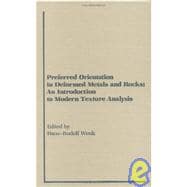
Note: Supplemental materials are not guaranteed with Rental or Used book purchases.
Purchase Benefits
What is included with this book?
| L.E. Weiss and H.-R. Wenk, An Introduction. H.-R. Wenk, Measurement of Pole Figures. L.E. Weiss and H.-R. Wenk, Symmetry of Pole Figures and Textures. H.J. Bunge, Representation of Preferred Orientations. H.J. Bunge and C. Esling, The Harmonic Method. H. Schaeben, A. Vadon, and H.-R. Wenk, Vector Method. S. Matthies and H.-R. Wenk, ODF Reproduction with Conditional Ghost Correction. D.J. Barber, Dislocations and Microstructures. G. Gottstein and H. Mecking, Recrystallization. T.G. Langdon, Regimes of Plastic Deformation. P. Van Houtte and F. Wagner, Development of Textures by Slip and Twinning. G. Oertel, Reorientation due to Grain Shape. H. Mecking, Textures of Metals. J. Hirsch and K. L cke, Interpretation of the Copper |
The New copy of this book will include any supplemental materials advertised. Please check the title of the book to determine if it should include any access cards, study guides, lab manuals, CDs, etc.
The Used, Rental and eBook copies of this book are not guaranteed to include any supplemental materials. Typically, only the book itself is included. This is true even if the title states it includes any access cards, study guides, lab manuals, CDs, etc.